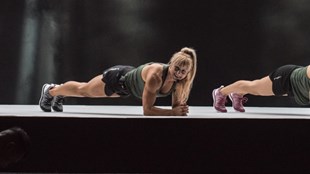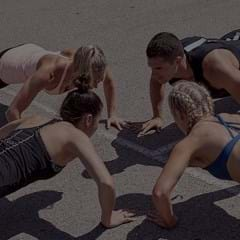SARAH SHORTT: Let’s start at the beginning – how did you end up needing surgery?
LISA OSBORNE: I noticed a pain in my hip a couple of years ago, and it was something I was managing for a long time – massaging it and rolling it out. It progressively got worse and we tried to fix it with rehab, but when I had an X-ray it showed that the head of the femur and hip joint was bone on bone – the cartilage has worn away. When I was referred to a surgeon he said that it was a degenerative condition and could not be fixed by rehab - I required a full replacement of my right hip.
Have you been scared that you won’t be able to teach again?
Yes. And that’s why I wanted to share this story with Instructors, to inspire them not to lose faith when you have tough times like this. You know, injuries happen, but you don’t have to give up. Teaching is my life - I love being with the members and it’s definitely hard at the moment. The other day, I cried on the side of the studio because I couldn’t teach track one. I had wanted to last one more week before my surgery but I was in so much pain, I was in real trouble so Ben [Main] had to teach the rest of the class for me.
But everyone gets upset about things. And I get upset, for sure. But you’ve just got to find ways to keep going. I’m pretty positive. I’ve spent my whole life listening to motivational quotes and laughing and surrounding myself with positive people, and I’m lucky to work for a company that is all about keeping on going and being fit for life, so I’m in the right place. And Jackie Mills, my boss, has always supported me so my mental journey has been really good.
You teach several BODYATTACK and BODYSTEP classes a week. How have you managed to keep teaching while being injured?
I’ve taken a lot of the modifications we offer and I’ve learned that doing the hardest or fastest option isn’t always the best! Over the last 12 months I’ve focused on doing moves well on the lowest level. If I do a hover on my knees and do it perfectly symmetrically, this is actually a lot harder than doing it badly on my toes with no engagement of the target muscles. I’ve learned that it’s harder to balance on one leg with the other leg out in front – activating your quads, keeping your hips square, bracing your abs and squeezing your glutes – than it is to do 20 squats – badly. My personal trainer, Mark, has taught me that.
I’ve struggled with teaching tracks three and eight over the last 12 months in BODYATTACK, because of the single knees and single leg kicks, so I have people to help me teach those tracks. I’m so thankful for the culture we have in our Tribe of helping each other out, and that we love teaching together. It’s important to ask for help if you need it - it doesn’t make you any less of a great Instructor. I think it shows authenticity and integrity as an Instructor to be real about these things.
I’ve found out what I can still do, and changed what I can’t do to keep going. In CXWORX, I can’t do the standing hip work in tracks three and four, but I do the first two tracks, and then come back in for five and six. It’s about not being too proud to say, I can’t do that, but I can still do this, and that’s still an achievement.
How has this affected your training?
It became really bad about 12 months ago, and Mark, my coach, actually noticed the imbalance before I did. I could feel it was a bit sore, but he noticed how much I was favouring my left side. He immediately took me back to basics with my movements and focused on keeping me square, but we realised that a lot of what I was doing was too heavy to maintain correct alignment.
We had to decrease a lot of my volume, which was incredibly frustrating. I’d say to him, “I’m square!” and he’d say, “Lisa, you’re not square.” I’d say, “I’m even! I’m doing both legs!” and he’d say, “You’re not, Lisa…” I know I frustrated him because I didn’t want to listen, but he was so good, he always made me do it and it was so helpful to have an extra set of eyes.
Jackie and Phillip have always supported us Program Directors to have a personal trainer – and not so that we can train harder, but rather to keep us balanced and strong for the programs that we teach. Mark was the one who said, “You have to be more balanced, you can’t do that, you have to do this move … you’re doing too much, you need to slow down.” He kept me going by modifying things for me and ensuring I was still keeping the right muscles firing so I could maintain my strength.
What has been the focus of your pre-hab?
The easiest thing with an injury like this is to become imbalanced. My absolute focus has been to work both sides of my body equally so I’m not getting strong on just one side and increasing the risk of injury. Even though I would hate it, Mark would make me stand on my bad leg for one minute as well as my good leg, and make me stretch out my right side as well as my left. A lot of people will favour one side of their body without even realising it. As soon as you find a weakness, it’s important to strengthen that side of the body, rather than just relying on your strong side.
I started doing CXWORX once I became aware of the pain, and that has helped immensely with staying strong and balanced. When I went in to see my surgeon, he couldn’t believe how strong my obliques were – he said he hadn’t seen such a strong injured side in a very long time.
How do you vary your training to stay strong?
It is so important to mix up your training to help prevent injuries. I’ve always believed that all of our programs are awesome, and if you can do a mix of them you will have a perfectly balanced training routine. Do a few BODYATTACK, BODYSTEP, BODYPUMP, CXWORX – don’t just do one program every single day. Every single person should do CXWORX at least once a week as the foundation of their strength.
We’re looking forward to following you over the next few months as you rehab from surgery. Do you have an immediate plan following your return from hospital?
My Mum and Dad are coming over from Melbourne to help with my children because I won’t be able to drive. And I’m going to change my stairs into a slide. I’m going to get a whole lot of cardboard boxes and make one side a slide. And I’m going to use tricep dips to get up the stairs backwards. It’s pretty hard, I’ve tried it! But we have a whole lot of stairs at home so it’s either that or I sleep in the garage.
I’ll start working with Mark again and he’ll have a programme for me to get back to teaching and training. My goal is to be able to film again in Shanghai on BODYATTACK 104. But mainly, I want to use my story to inspire Instructors, and in turn for them to use it to inspire their members. Because you never know when you might be in that position yourself. That’s what this injury has taught me – to have more empathy with the people in my class and make sure I’m offering options that will mean everyone can tailor the workout to suit their ability, wherever they are today. It’s about using self-discipline and focus, and changing up what you need to. My mantra at the moment is: adapt, react, then get on with it. It’s what is keeping me going.
Lisa had her surgery on 24th July, it went successfully and she appeared on crutches at the filming of BODYATTACK 103. Be sure to read the next edition of Tribe Talk for Part 2 of Lisa’s rehab journey.








